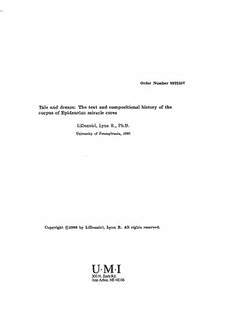
Tale and dream: the text and compositional history of the corpus of Epidaurian miracle cures PDF
Preview Tale and dream: the text and compositional history of the corpus of Epidaurian miracle cures
Order Number 8922557 Tale and dream: The text and compositional history of the corpus of Epidaurian miracle cures LiDonnici, Lynn R., Ph.D. University of Pennsylvania, 1989 Copyright ©1989 by LiDonnici, Lynn R. All rights reserved. U M I 300 N. Zeeb Rd. Ann Arbor, MI 48106 TALE AND DREAM: The Text and Compositional History of the Corpus of Epidaurian Miracle Cures LYNN R. LiDONNICI A DISSERTATION m Religious Studies Presented to the Faculties of the University of Pennsylvania in Partial Fulfillment of the Requirements for the Degree of Doctor of Philosophy. 1989 Robert A. Kraft Supervisor of Dissertation Graduate Group Chairperson COPYRIGHT LYNN R. LiDONNICI 1989 iii Dedicated with gratitude and affection to Professor Tamara M. Green (xuaTotyoyoc ACKNOWLEDGEMENTS I am glad to have this opportunity to thank all of those whose help, patience and advice have seen me through the completion of this dissertation. I especially thank Professor Robert A. Kraft for his aid and inspiration throughout my years of graduate study; and for his "wit" (in both senses of the word). I am also grateful to Professor Guy Welbon for reading this dissertation and for all his help in many other areas; to Dr. David G. Romano, for much helpful advice on archaeological matters; and to Prof. Jon Mikalson who, although we have never met, suggested Asklepios as a potentially fruitful area of study— he was right. I thank as well my wonderful professors at Hunter College, three Great Ladies who inspired and encouraged me: Professor Tamara M. Green, Professor Jean R. Bram, and the late Professor Claireve Grandjouan. Many of my friends and fellow graduate students have suffered through this project with me and have given valuable help. Comments and suggestions by Dr. Benjamin G. Wright were extremely helpful for revisions; and it is unlikely that this dissertation would ever have become "hard copy" without his assistance. I thank Dr. Michelle V Marcus for reading an early version and giving helpful comments, and Ms. Dena Salmon for providing support, suggestions and humor. I am also greatly indebted to my parents, Kenneth and Marie LiDonnici, who made my graduate education possible not only financially but by teaching me to love books— a precious gift. ABSTRACT TALE AND DREAM: The Text and Compositional History of the Corpus of Epidaurian Miracle Cures LYNN R. LiDONNICI Robert A. Kraft, Supervisor The corpus of healing reports from the worship of Asklepios at Epidauros, the "Iamata" (cures), survives in the form of four large stelai, IG IV I, 121-4. These fourth-century stelai preserve approximately 70 tales of healings and other miraculous events. It is generally agreed that the corpus represents a collection of tales from individual votive plaques dedicated by suppliants, combined with an oral and/or priestly tradition, but there has been little study of the sources for tales and the manner in which they were compiled. Form-critical analysis of the tales on each stele reveals several groups which share thematic material and/or linguistic style. These groups and patterns suggest divergent sources and a variety of conditions influencing the formation of the tales. Some groups may indicate that officials or votive-sellers could recast the details told them by the grateful patients into a convenient or devotionally correct format, creating resemblances or families of tales. This may have occasionally involved the introduction of narrative elements to reflect the pictorial representation on a vii votive which a merchant may have already had "in stock." Orally-circulating stories inspired by certain votives or other elements in the sanctuary may also have played a role in forming’relationships between disparate tales. The groupings of tales also suggest two or more previous episodes of collection of tales from votives, occurring at different times in the sanctuary's development, and reflecting the aims and concerns of the patients and authorities at different periods. The identification of these groups opens up the possibility of establishing of a relative chronology for the Iamata, which indicates changes over time in the aims and concerns of the sanctuary officials and in the types of dreams and miracles expected by suppliants at different periods. This adds a further level of significance to the study of a corpus which is already a valuable source of information about personal religious thought and activity in the late Classical period. viii TABLE OF CONTENTS List of Plates................. .....................ix List of Tables........................................x Chapter 1: INTRODUCTION..............................1 Chapter 2: ARCHAEOLOGICAL CONTEXT Part 1. The Sanctuary....................... 15 Part 2. The Inscriptions.................... 36 chapter 3: TEXT, TRANSLATION and NOTES Part 1. Stele A..............................45 2. Stele B..............................68 3. Stele C..............................99 4. Stele D.............................130 Chapter 4: THEMATIC AND LINGUISTIC PATTERNS IN THE IAMATA Part 1. Source Material for Tales.......... 134 2. Description of Patterns............ 154 Chapter 5: INTERPRETATIVE MODELS Part 1. Pictorial Representation, Oral Tradition, and Sanctuary Location.........205 Part 2. Artisan Composition and "Stock" Influence............. 226 Part 3. Redaction; Multiple Redaction? Priestly Tradition.............238 Part 4. Historians and Medical Writers..... 248 Part 5. Summary.............................257 Chapter VI: CHRONOLOGICAL ISSUES....................25 8 Chapter VII: CONCLUSIONS AND PROSPECTS..............273 BIBLIOGRAPHY........................................281 APPENDICES Home Towns of Suppliants.....................293 Death and Birth at Epidauros................ 296 Numbering Concordance....................... 303 PLATES.............................................. 304
